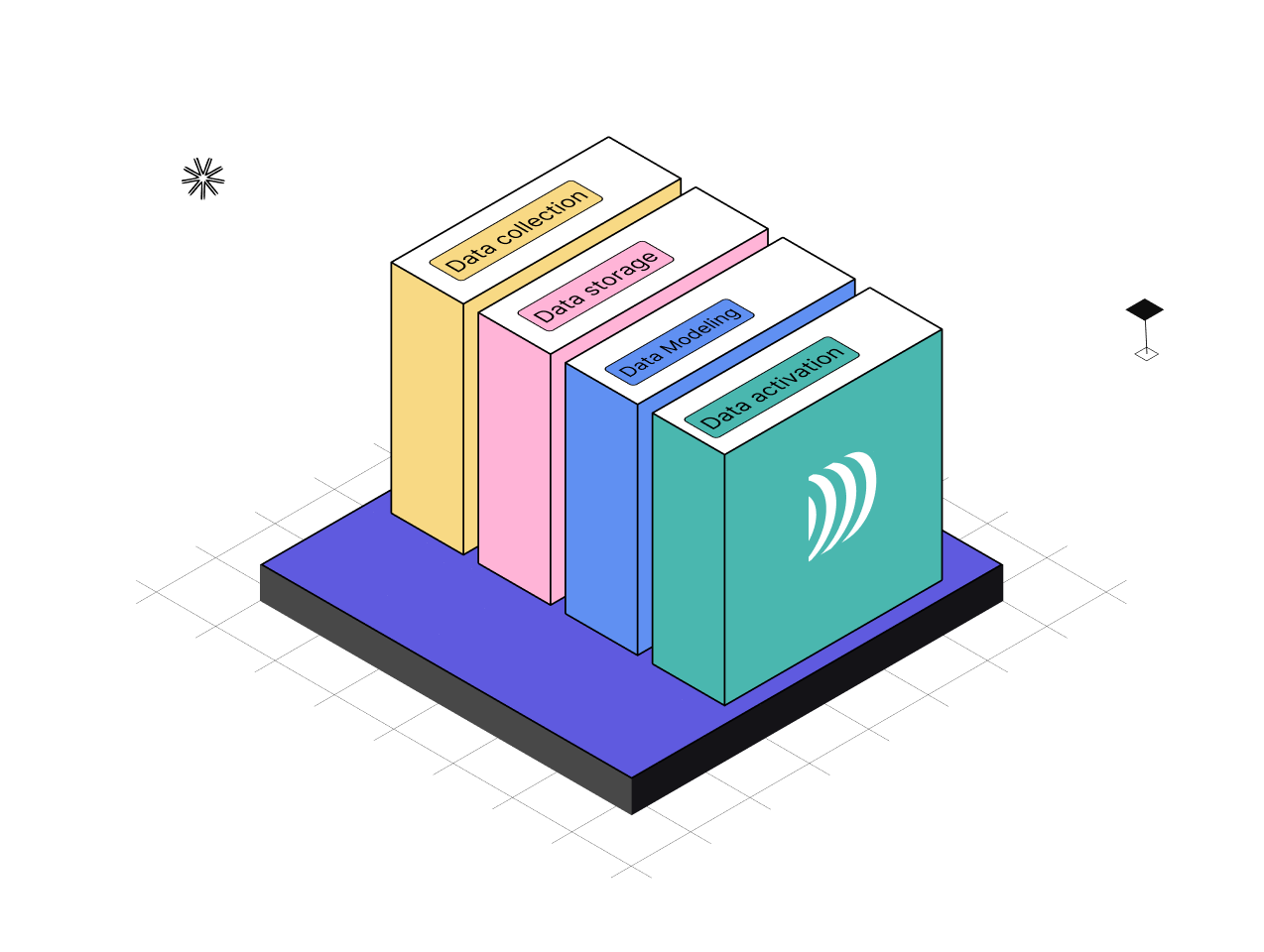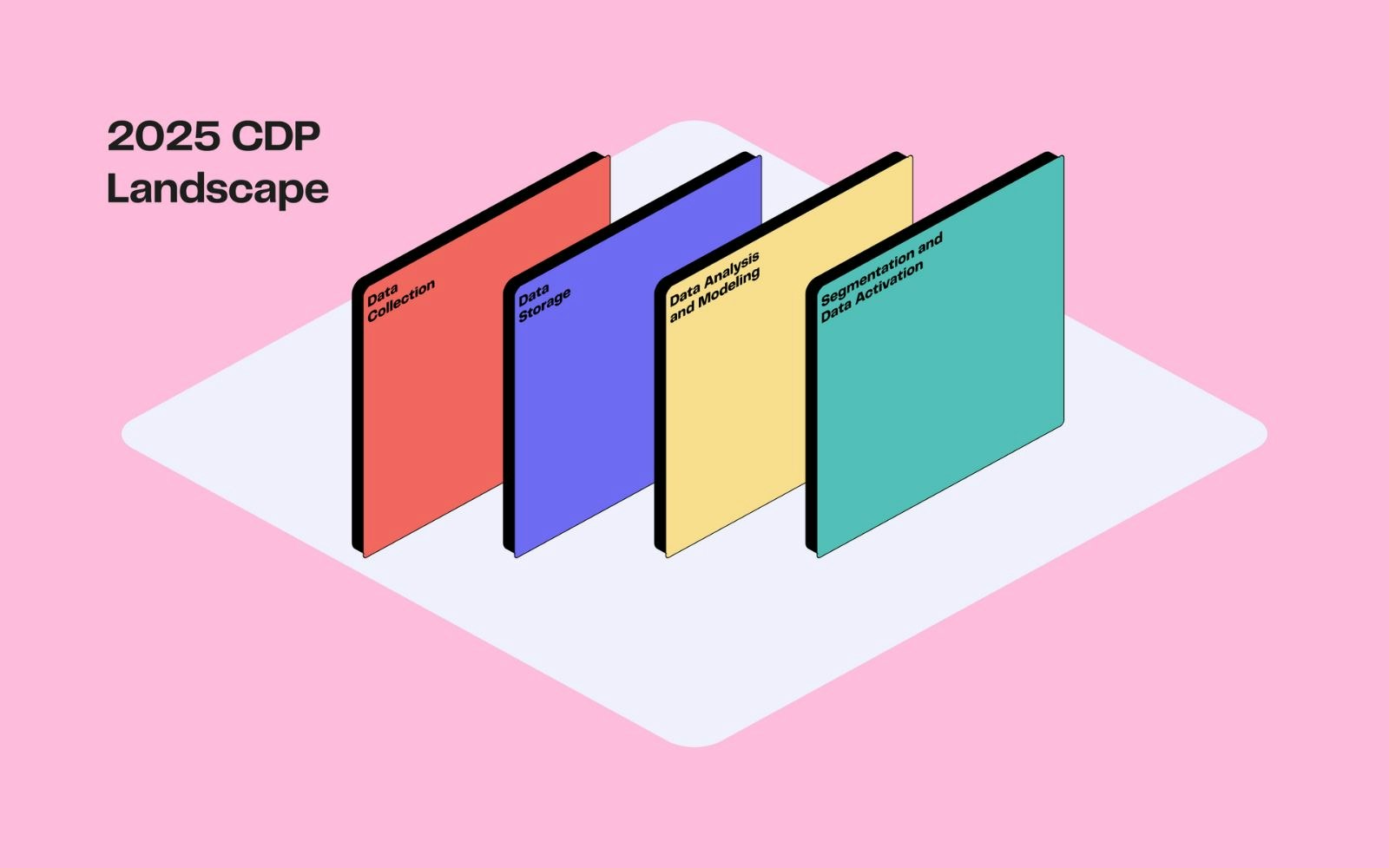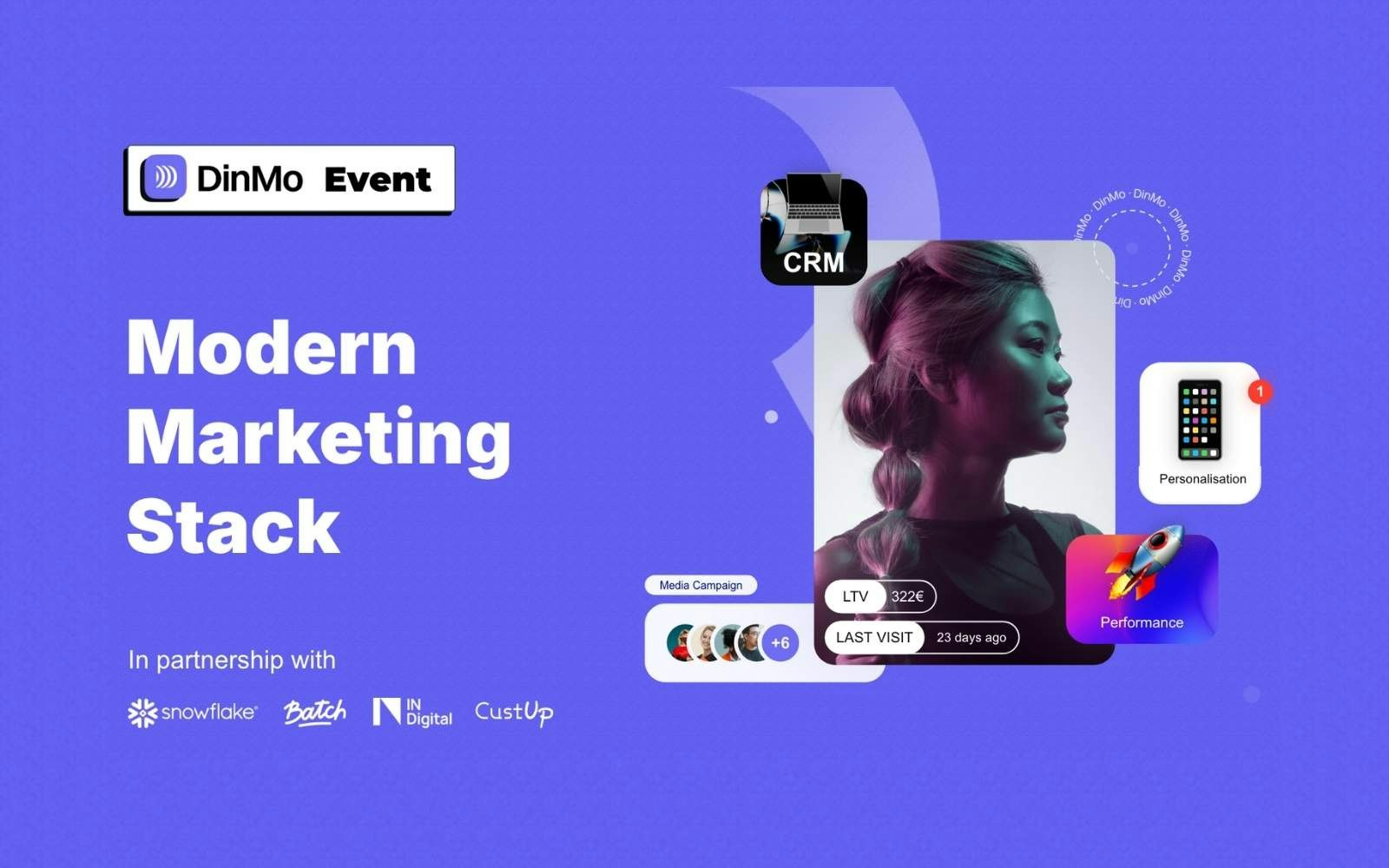Personalisation is an essential marketing lever. It involves creating unique experiences to enhance customer engagement. This means knowing your audience inside out.
Historically, companies have adopted Customer Data Platforms (CDPs) to centralise and manage their customer data. However, traditional CDPs are considered expensive and inflexible, and they struggle to to deliver a satisfactory return on investment.
Composable, or modular, CDPs offer a more flexible and tailored approach, by integrating with companies' existing infrastructures.
Key Takeaways:
A composable CDP differs from an integrated or traditional CDP through its modular and flexible architecture.
It leverages data from a data warehouse, preventing data duplication and enhancing security.
It’s easier to implement, so it is perfectly suited to Modern Data Stacks. It takes just 30 minutes to set up.
It’s user-friendly and efficient by enabling real-time data activation, facilitating highly personalised and effective marketing campaigns. This is why it is also referred to as an Experience CDP (xCDP).
🤔 Find out why composable CDPs are increasingly being adopted. Understand how they work and how they differ from traditional packaged CDPs.
What is a composable CDP?
A composable CDP is a modular solution that uses your existing infrastructure to collect, model and activate customer data.
It leverages the repository of a data warehouse, which already contains a detailed mapping of the customer journey. Rather than operating as a separate entity, the composable CDP integrates seamlessly into your environment.
Oussama Ghanmi, founder and CEO @DinMo
The very essence of a composable CDP lies in its ability to use existing data layers within the data warehouse.
This approach eliminates the need for an additional data storage or management tool. It enables customer data to be activated directly for marketing operations.
By doing so, it substantially shortens the time to value and reduces the complexity of data management.
Key benefits of a composable architecture
The composable CDP, which is more economical, simple, and flexible, offers a number of advantages. These benefits are summarised below:
It establishes a single source of truth for customer data, residing in the data warehouse/lakehouse with robust identity resolution. This can serve all data usage purposes, such as data science, analytics, audiences, and activation.
It is therefore much faster to implement. The first use cases can be operational within a day, compared with several months for a packaged CDP.
It's also more cost-effective thanks to its Best of Breed approach. You only pay for the components you need, with no unnecessary expenditure. By avoiding duplication, storage costs are reduced.
It moves away from rigid data models, offering flexibility in handling and unifying data. Your business, your model.
Composable CDPs are distinguished by their ability to integrate diverse data assets without conforming to a specific structure. This flexibility allows businesses to tackle more intricate customer data challenges effectively, ensuring that data resolution issues are minimised and audience insights are fully leveraged.
It offers enhanced data security, improving data compliance and governance at scale. Indeed, by processing data directly from your data warehouse, Composable CDPs enhance security, ensure compliance with the strictest regulations (GDPR and CCPA), provide flexibility, and drive cost efficiency. For marketers, embracing a composable CDP is a strategic move towards a future of more secure and efficient data management.
It provides greater control over customer identity unification and improved data governance. A composable CDP is technology agnostic and integrates with any data infrastructure.
Traditional CDPs only understand clickstream data, ignoring the complexity of your business. Various offline actions, data science prediction models, and unique user attributes are overlooked and inaccessible when using a packaged CDP.
💡 Several players in the market favour the composable approach over the packaged or hybrid approaches. Snowflake, for example, highlights this in its annual report on the Modern Data Stack.
How does it work?
The composable CDP can be thought of as an intermediary layer that bridges your data warehouse with your business tools. It does not store data independently, but rather leverages the rich environment of the data warehouse.
The core components of a Composable CDP are comparable to those of a Traditional CDP:
Data Integration: This involves collecting customer data from different sources. This data can be collected in real-time (using tools such as Segment) or in batch via ETL processes.
Data Centralisation and Modeling: Once the data from the various sources has been integrated into a data warehouse, it needs to be reconciled and modeled using unique customer identifiers such as email or customer ID.
This provides a 360° view of customer interactions. This view is organised in a data model into entities centred around the customer (consumer profiles, transactions, product interactions, etc.).
Data Enrichment: The 360° view of customers available in the data warehouse can be enhanced with intelligent and predictive attributes such as churn risk, LTV (Lifetime Value) or product interest.
This enables more intelligent activation of marketing campaigns. This feature is particularly useful in B2C contexts with a large customer base and a wide range of products.
Data Activation: This crucial stage involves synchronising data with all the business tools used to communicate with customers (CRM, ads, support, etc.).
It is the cornerstone of composable CDPs, because it ensures that the customer view is consistent across the various tools used by the company. This functionality is achieved via Reverse ETL processes.
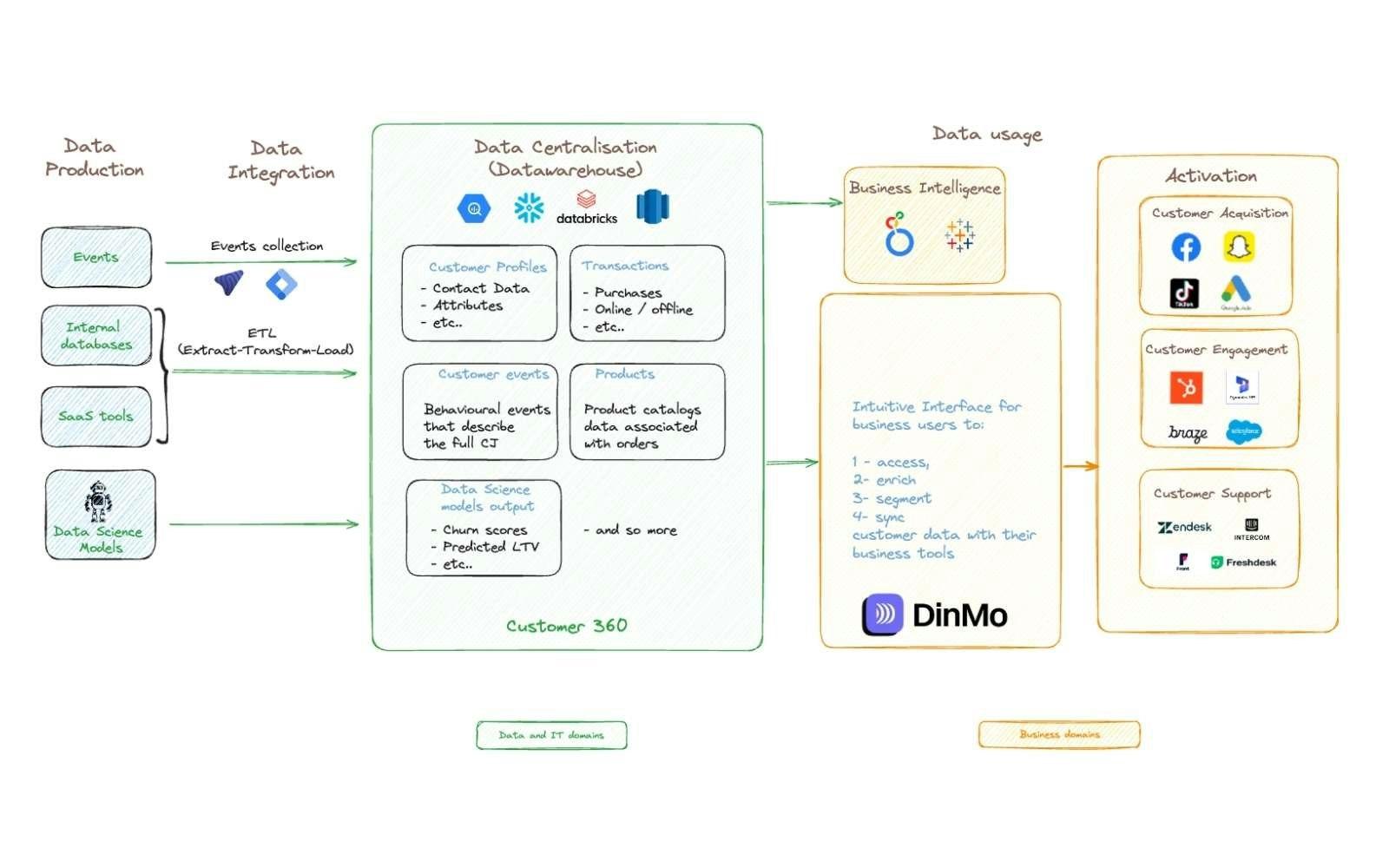
How the DinMo composable CDP works
Steps to build a Composable Customer Data Platform
By now, you’re probably convinced about the importance of data activation. But you may be unsure whether to buy a Reverse ETL platform or build custom API connectors to link your data warehouse with operational systems.
Put simply, there's little value in your data team building and maintaining pipelines for Reverse ETL:
Manually creating API connectors can take days or weeks, even for experienced data teams.
API endpoints often can't handle real-time data transfers
Applications are constantly evolving, meaning continuous maintenance of existing connectors
However, turning your existing data infrastructure into a Composable CDP is very easy with DinMo. You can implement your first marketing use cases in minutes!
If you'd like to see a demo of how this can be done, go here 👇

Your Composable CDP in minutes
Book a demo with us to see how your organisation can implement its own Composable CDP in minutes
The different stages:
Configure your workspace: Connect to your source (i.e. your data warehouse) and your destinations where you want to activate data.
(note: we only have read access, we will never store your data)
🌟 DinMo is the only European CDP with the Google Cloud BigQuery Certification, meaning that we integrate seamlessly with BigQuery for supercharged data handling.
❄️ If you chose Snowflake as a data warehouse, no worries! We also have a strategic partnership with Snowflake!
Build your data model: Choose what data you want to activate, so that marketers can operate independently using the entities defined by your data team.

Model your business and connect it to DinMo
Build your audience: Create audience segments in seconds thanks to our visual Segment Builder
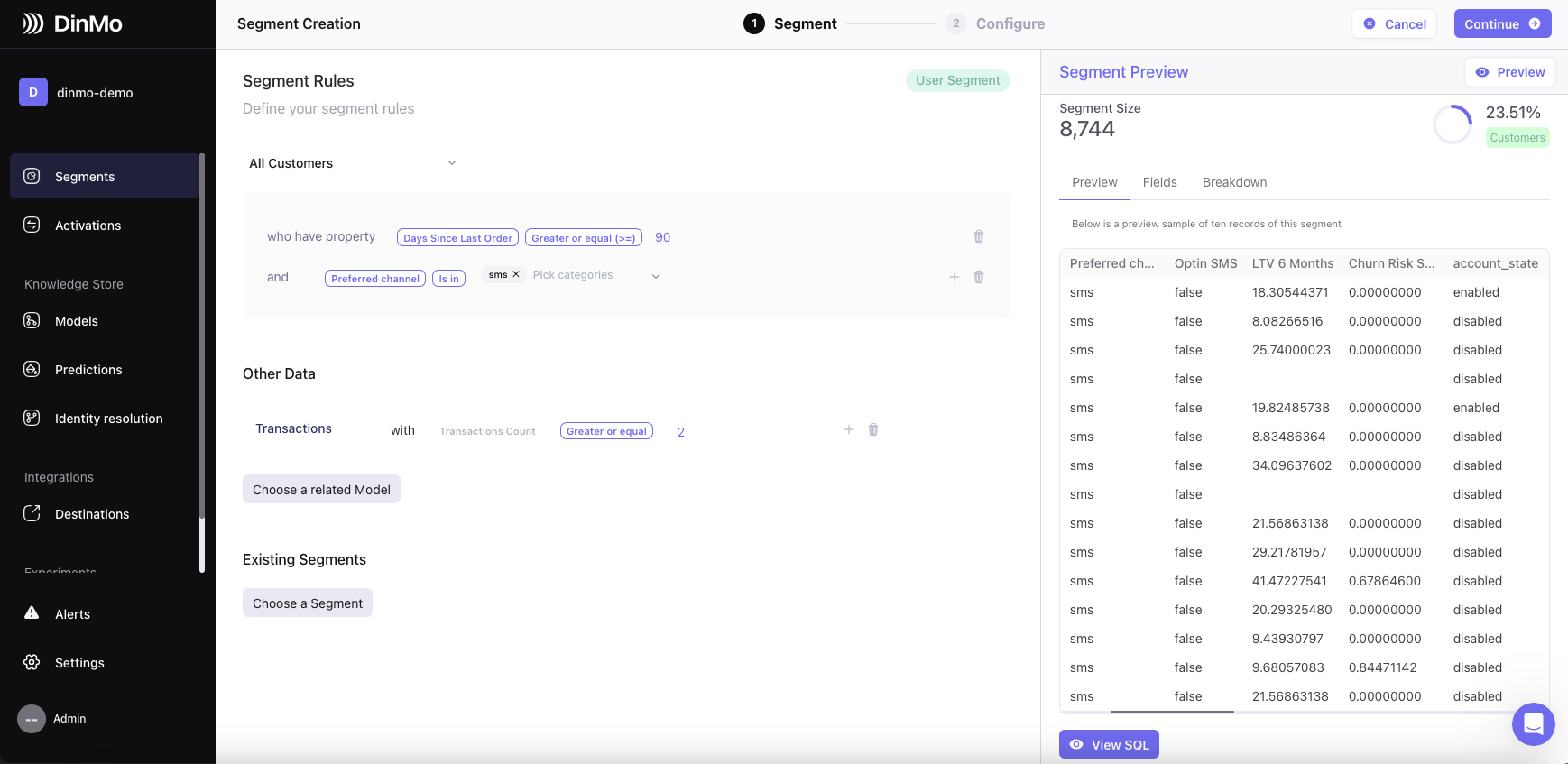
Visual segment builder DinMo
Activate your data: Send the audiences you just built to your downstream tools
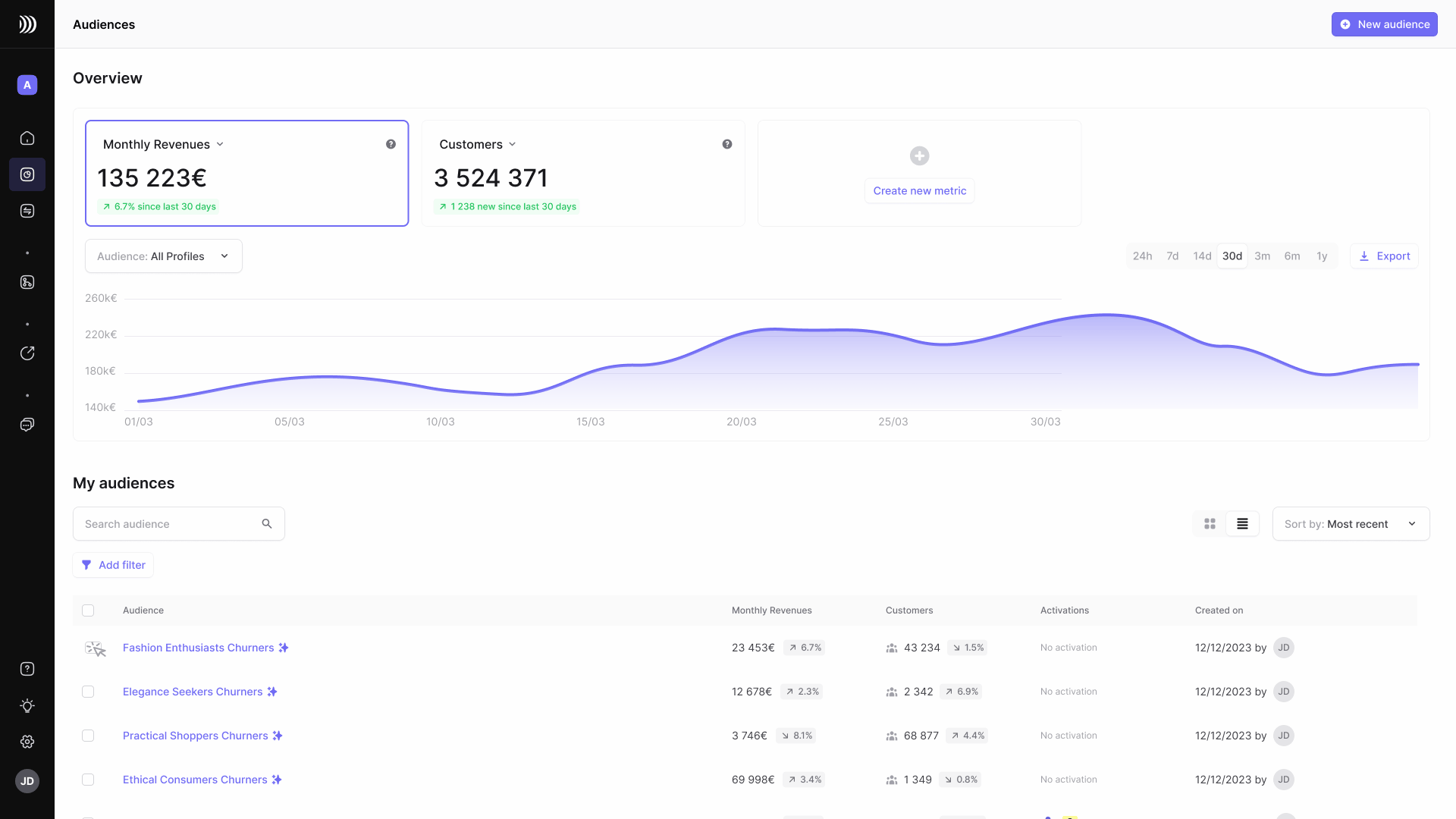
One-click activation
Find out more about how Ankorstore reduced its CAC (Customer Acquisition Cost) by 20%.
Composable CDP vs packaged CDP: what are the differences?
Take a look at our article on the differences between a traditional CDP and a Composable CDP, and download our comparison guide 👇
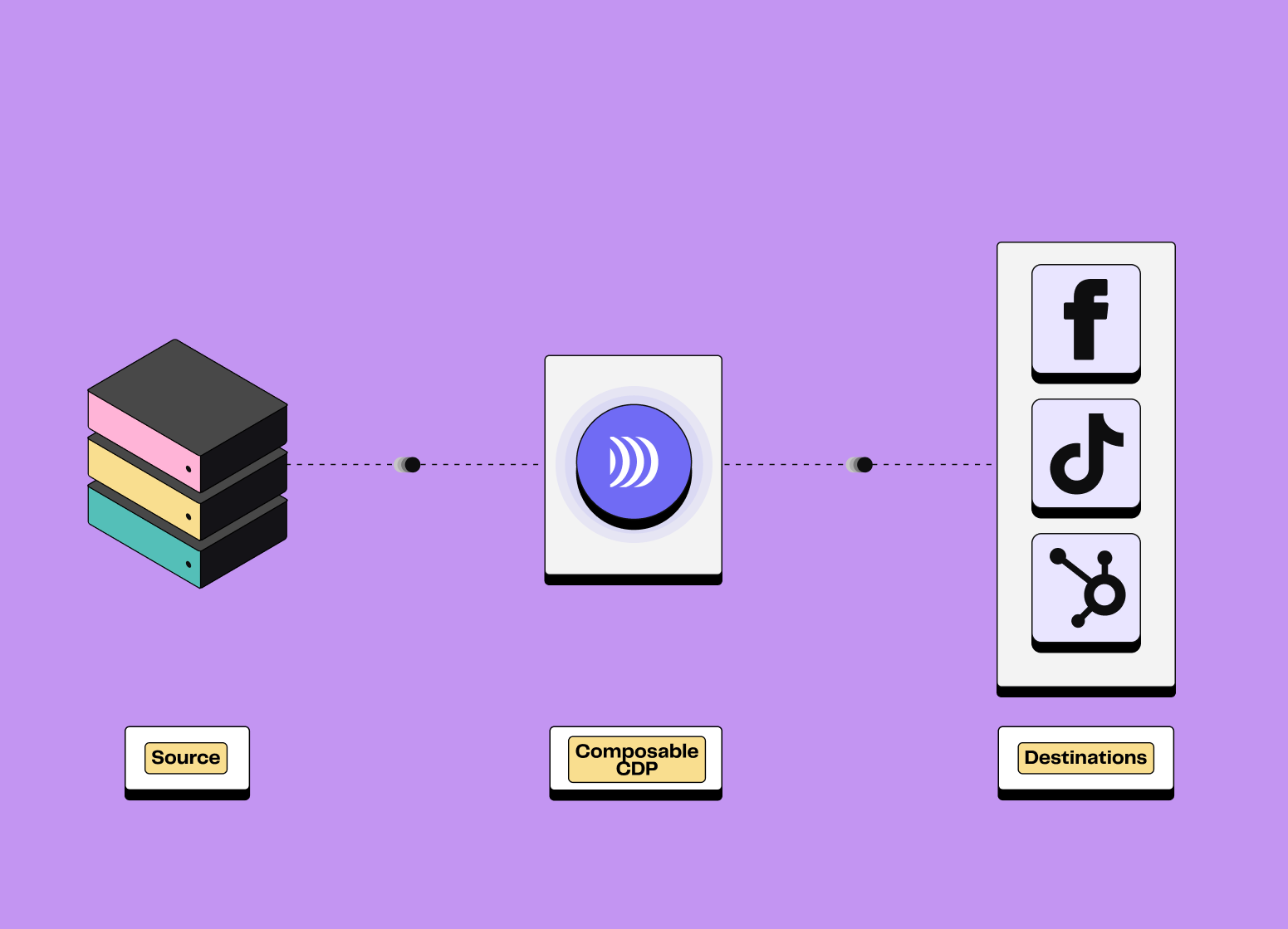
Comparison guide
What's the difference between Traditional and Composable CDPs?
Rigidity versus flexibility
With recent changes to consumer privacy and increasing restrictions on third-party cookies, the ability to effectively capture and harness first-party data has become more critical to business survival than ever and, quite frankly, is now the basic requirement for delivering highly personalised experiences and remaining competitive.
Traditional Customer Data Platforms (CDPs) have long been the backbone of customer data management and activation, offering a centralised repository for various data sources (behavioral data, first-party attributes, customer insights, etc.).
These platforms primarily focus on aggregating and unifying customer data from different systems, thereby providing a single customer view. This unified data is then made accessible to marketing teams for analytics and other use cases.
Despite their centralised nature, traditional CDPs often come with significant challenges. A primary concern is the rigidity of data storage within predefined models. This one-size-fits-all approach can be limiting, as each business has unique data needs and structures.
We highlighted this issue when launching our Knowledge Store at DinMo. We are convinced that companies must use tools with adaptable data models that cater to their specific business and teams requirements.
Duplication vs. single origin: the evolution towards composable CDPs
Furthermore, many data teams have already centralised their customer data in a data warehouse, a data lakehouse, or another storage solution. It creates a potential issue of data duplication when implementing a traditional CDP.
This duplication not only complicates data management but can also lead to inconsistencies, with the data warehouse and the CDP potentially serving as conflicting sources of truth.
With over 80,000 companies now using data warehouses, the approach to data collection, centralisation and customer journey mapping has significantly evolved. Cloud data warehouses have become the richest sources of customer data, meticulously capturing both online and offline customer interactions.
This evolution sets the stage for a new paradigm in customer data platforms and the Modern Data Stack: the composable CDP.
👉🏼 There is a growing preference among businesses to use a Composable CDP, given its flexibility and agility in adapting to various data sources and structures.
This shift reflects a fundamental change in the CDP market, where companies no longer see the need to purchase standalone systems when they already have a robust data infrastructure and modern stack.
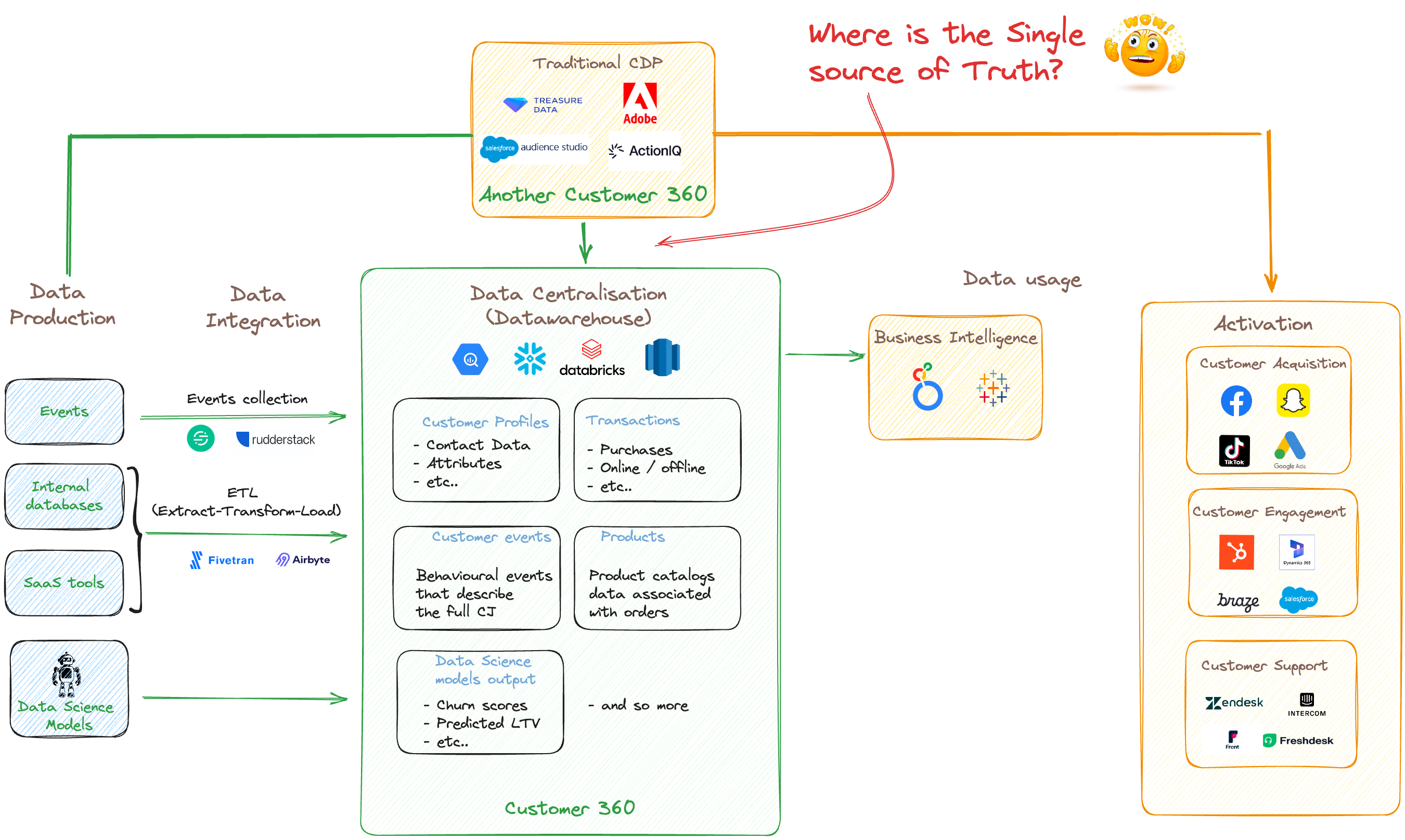
Traditional CDPs duplicate data, negating the concept of "Single Source of Truth"
Differences in cost and ROI
Another critical point to consider is the high cost and complexity associated with implementing traditional CDPs. These platforms often require significant investment, both in terms of financial resources and time, involving significant effort from both marketing and data teams.
The complexity of integrating various data sources into a rigid, vendor-specific architecture further adds to this challenge, leading to a prolonged time to value.
This delay can be particularly problematic in a fast-paced business environment where agility and quick adaptation to data insights are crucial for maintaining competitive advantage and customer satisfaction.
A Composable CDP offers more flexibility to address complex use cases. Its architecture, free from traditional CDP limitations, provides greater control and specificity in building audiences and cohorts and powering complex marketing scenarios.
You can build and define audiences granularly thanks to behavioural data, offline interactions and Data Science metrics
You can transmit more data (first-party attributes, predictive metrics, etc.) to your ads, CRM or support platforms, improving your customer knowledge and then lowering your Customer Acquisition Costs (CAC)
You can create more personalised customer experiences by orchestrating user journeys across marketing platforms and performing A/B testing in real time for various audiences
Why talk about a Modular CDP?
At DinMo, we adopt the term 'Modular CDP' to better encapsulate our approach to what is traditionally known as a Composable CDP. This preference stems not just from the feature set, but primarily from our overarching vision and strategy. This is a key point of difference from our competitors.
The concept of a composable CDP often revolves around a technical framework, rooted in the idea of a 'Best of Breed' model. This approach typically involves assembling a range of features and platforms, each purpose-built for specific functions. However, while the technical capabilities are important, at DinMo, we prioritise the business application and impact.
The modularity of our architecture allows you to focus on your marketing use cases rather than on "technology stacks." Many organisations need to solve use cases, but they often think too broadly about technologies. They fail to realise that they simply need a method to utilise and activate their existing data. Implementing the right solutions can streamline campaigns and improve organisational efficiency.
We believe that the journey to becoming data-driven should be pragmatic and focused on ROI from day one. This means enabling clients to start small. Companies can start by focusing on immediate and tangible benefits, such as improving customer exclusions in acquisition campaigns.
From there, the system can evolve in complexity and scope, seamlessly adding more data, functionalities, and user personas. This modular approach ensures that the platform grows in tandem with the company's maturity, continuously delivering value at every stage.
A Modular CDP with DinMo allows for a gradual expansion of capabilities, enabling marketing teams to activate their customer data. Begin by establishing fundamental audience strategies, then move on to incorporating conversion events.
As the system matures, integrate more advanced features and use cases, such as scoring models and, eventually, predictive analytics. This progression ensures that each step is beneficial and aligned with the current needs and capabilities of the business.
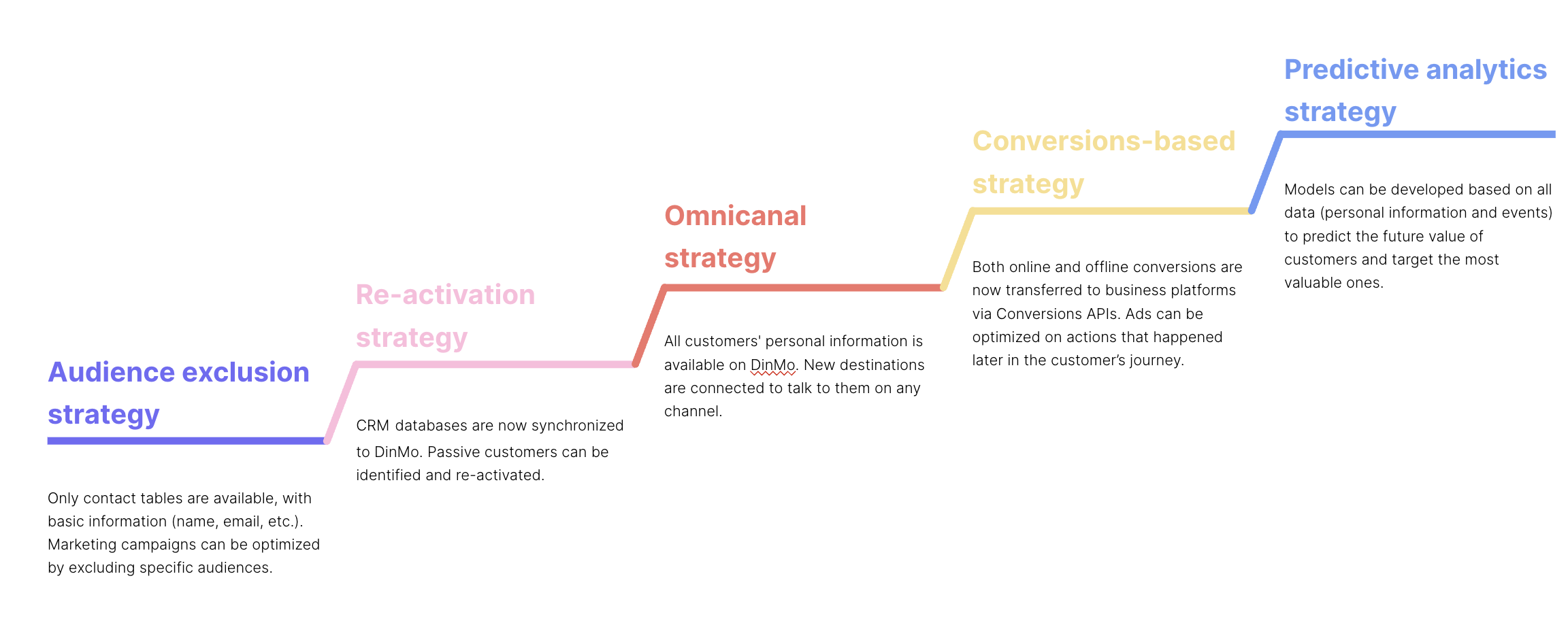
Composable CDP: A Modular Approach
Final thoughts
🚀 Curious to see it in action? Get in touch for a free demo and find out how our Modular CDP fits your business needs.
FAQ
Is it possible to build a Composable CDP without a data warehouse?
Is it possible to build a Composable CDP without a data warehouse?
On paper, having a data warehouse is not strictly necessary. What matters is having a database that brings together all customer data to power your business platforms.
That said, we often recommend using a cloud data warehouse, as it offers greater flexibility and scalability, allows data to be properly structured, and integrates seamlessly with your existing data stack. Setting up a data warehouse is made easier by ETL tools and enables you to build a 360 customer view in just a few days.
What are the most common use cases for Composable CDPs?
What are the most common use cases for Composable CDPs?
The use cases for composable CDPs are broadly the same as those for Reverse ETLs:
-
Improved ads campaigns thanks to better customer segmentation & data enrichment (conversions data, predictive metrics, conversions adjustments, etc.)
-
Automation and personalisation to meet customers exactly where they are in their buyer journey and then increase customer lifetime value (CLV).
-
Enhanced sales operations thanks to data enrichment and alerting, transforming the way sales teams interact with potential customers.
-
More effective customer support thanks to smarter prioritisation and always up-to-date data.
-
Significant time savings for data teams, thanks to automation and reliable data delivery to business platforms. No more building and maintaining APIs or writing SQL queries — they can focus on high-value tasks instead.
How can I be sure that the composable CDP meets my company's needs?
How can I be sure that the composable CDP meets my company's needs?
The first question to ask yourself is whether or not you need a CDP.
If the first answer is yes, it depends on your existing data environment and future developments in your company. If you have already capitalised on a data cloud infrastructure and you have high marketing stakes, don't hesitate to contact us to test our composable CDP.
Why choose DinMo over other Composable CDPs?
Why choose DinMo over other Composable CDPs?
Hightouch or Census take the problem as an integration one. They address the needs of data teams (connecting platforms) more than those of the business and marketing team.
It's not for nothing that their "no-code" features are exclusive to their premium plans.
If you want to start small, with a few destinations and a few segments, without needing help from your data team, this is simply not possible with these tools.
For more information, see the comparison table below.
Feature | DinMo | Hightouch | Census |
|---|---|---|---|
No code segment builder | ✅ For all pricing plans | ⚠️ For “Business” plan only | ⚠��️ For “Enterprise” plan only |
Knowledge Store | ✅ Model creation & mapping | ⚠️ Limited functionality that still requires technical skills | ⚠️ Limited functionality that does not include mapping |
One-Click activation | ✅ Fastest audience activation | 🚫 Go through the entire setup every time | 🚫 Go through the entire setup every time |
Data Enrichment | ✅ LTV, churn, predictions and more | 🚫 Data engineers needed | 🚫 Data engineers needed |
Performance Analysis | ✅ AI generated reports to assess the performance of the customer base | ⚠️ Only structural insights (e.g. size, matching) | ⚠️ Only structural insights (e.g. size, matching) |
Marketing recommendations | ✅ Recommandations on new audiences, improvements,etc. | ✅ AI-decisioning that helps identifying best marketing actions | 🚫 No recommandations |
Data Analytics | ✅ Measuring campaigns performance & answering to business questions | ⚠️ Limiting functionalities thanks to AI-decisioning | 🚫 Not available |
DinMo vs. Hightouch vs. Census

















